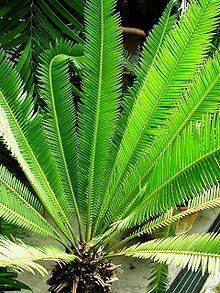Order Cycadales Higher classification Dioon | Scientific name Dioon purpusii Rank Species | |
 | ||
Similar Dioon, Cycad, Dioon caputoi, Dioon merolae, Zamiaceae | ||
Dioon purpusii (Purpus' cycad) is a cycad tree endemic to a very small region in Mexico (Oaxaca, Puebla).
Contents
Name
The epithet purpusii, chosen by Joseph Nelson Rose, is an homage to one of Rose's contemporaries, colleague Carl Albert Purpus (1851–1941) (cf. Echeveria setosa Rose & Purpus).
Description
Dioon purpusii grows about 5 meters high or taller, with a dbh about 40 cm being typical.
The leaves of D. purpusii look like long (80 to 160 cm.) feathers sprouting from the top of the trunk at odd angles. They are compound, and can be flat or keel-shaped, and are a dark, lusterless gray-green. Each leaf is composed of a rachis with between 150 and 260 narrow (about 7–12 cm. long, 8–10 mm. wide), inserted leaflets attached. The leaflets are arranged along the somewhat flattened rachis in matching symmetrical pairs without alteration. They do not grow perfectly perpendicular to their rachis, but point up and away from the petiole, all at approximately the same angle (this can be 120 degrees, 180 degrees, or any angle in between). The first five to twenty centimeters (depending on the overall length of the leaf) are fully formed leaflets, which are straightly lanceolate with flat, dentate margins; those growing towards and at the end of the rachis reduce to mere spines.
Seeing the difference between male and female cones is not difficult with D. purpusii. The seed cones (female) are large (35–45 cm.; 15–20 cm. diam.), pale brown and ovoid and contain similarly shaped seeds (3–4 cm. x 2.5–3.5 cm.) with cream-colored or white sarcotestas. The green or palidly brown pollen cones (male) are long (20–30 cm.), narrow (7 or 8 cm. diam.), and also ovoid.
Pests
Infestations of Aulacaspis yasumatsui, otherwise known as cycad aulacaspis scale, have been known to affect D. purpusii.
Conservation status
The International Union for Conservation of Nature and Natural Resources has assessed its status (2003) as "Vulnerable", with numbers trending downwards.
